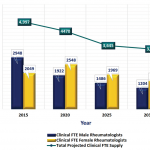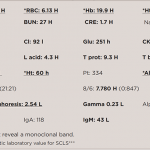WASHINGTON, D.C.—A friendly, but stern, voice talks to Joseph Kvedar, MD, vice president of Connected Health at Partners HealthCare, from his smartphone. Dr. Kvedar has just woken up. “Good morning, Joe! Here’s the tale of the tape. Your blood pressure and cholesterol are fine. Your sleep deficit is now up to three hours for the week….

Electronic Medical Records Have Mixed Impact on Quality, Quantity of Healthcare
The widespread implementation of electronic medical records (EMRs) and electronic health records (EHRs) has significantly changed the quality and quantity of healthcare for both the better and the worse. The digitalization of medical records provides comprehensive documentation of all events and actions associated with an individual’s medical care. Likewise, legibility, accountability and credibility are greatly…
The ACR Insurance Subcommittee Advocates for Fair Payer Policies
The ACR is committed to advocating for appropriate coverage and payment policies. The volunteer members of the Insurance Subcommittee (ISC) lead this effort by representing the ACR and its membership to the insurance industry. The ISC engages payers to ensure their policies are clinically appropriate and promote patient access to high-quality care and treatment. The…
Rheumatology Coding Answer: Deconstructing Evaluation and Management Codes
Take the challenge. Answers: B: No—Only the treating physician can take the HPI. The medical assistant is allowed to take the review of systems. If the documentation indicates the treating physician did not take the HPI, the insurance can deny the claim as not medically necessary. B: No—If the high-risk medication is not assessed and…

2015 ACR/ARHP Workforce Study of Rheumatology Specialists Predicts Future Workforce Shortfall
Ten years have elapsed since the ACR conducted its last workforce study, and we know that much has changed. The comprehensive patient-centered, integrative approach to the 2015 ACR/ARHP Workforce Study of Rheumatology Specialists in the United States (now publicly available) describes the character and composition of the current clinical workforce, recognizes demographic and employment trends,…
Clinicians May Have Inaccurate Views of Benefits, Harms of Treatments & Tests
NEW YORK (Reuters Health)—Clinicians’ expectations of the benefits and harms of a wide range of treatments and tests are rarely accurate, according to a new study. “There was variation—with benefits and harms sometimes being overestimated and sometimes being underestimated; but there was a tendency for clinicians to more often underestimate (rather than overestimate) harms and…

Chart a New Course: A Rheumatologist Talks about Practicing in an Orthopedic Environment
Working as a rheumatologist in an orthopedic practice has its own unique challenges, but may result in better patient care, according to Sheeja Francis, MD…

The Future of Pediatric Rheumatology Grounded in Evolution of Childhood Arthritis and Rheumatology Research Alliance
Pediatric rheumatology was formally recognized as a specialty in 1991 by the American Board of Pediatrics. Prior to this time, children with rheumatic diseases were treated by a hodgepodge of providers. In addition to providers who had training as pediatric rheumatologists, general pediatricians, adult rheumatologists, allergist-immunologists, orthopedists, pediatric infectious disease specialists and others treated children…

Rheumatology Case Report: Systemic Capillary Leak Syndrome and Rheumatoid Arthritis
Systemic capillary leak syndrome (SCLS) is a very rare disorder, characterized by recurrent episodes of severe hypotension, hypoalbuminemia and hemoconcentration.1 Attacks of SCLS occur in three phases: 1) prodrome; 2) hypovolemia with weight gain; and 3) hypervolemia with fluid overload and polyuria often complicated by pulmonary edema. Often, compartment syndrome can lead to rhabdomyolysis as…

How Hospital Design Can Promote Better Patient Outcomes
A storm has been brewing down the street from my office. It is a David & Goliath dispute, pitting young children and their families against a renowned pediatric institution, Boston Children’s Hospital. It concerns the fate of a half-acre swath of green space, the Prouty Garden, replete with meandering paths, fountains and a towering redwood…
- « Previous Page
- 1
- …
- 25
- 26
- 27
- 28
- 29
- …
- 87
- Next Page »